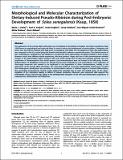Por favor, use este identificador para citar o enlazar a este item:
http://hdl.handle.net/10261/80497COMPARTIR / EXPORTAR:
 SHARE SHARE
 CORE
BASE CORE
BASE
|
|
| Visualizar otros formatos: MARC | Dublin Core | RDF | ORE | MODS | METS | DIDL | DATACITE | |

| Título: | Morphological and Molecular Characterization of Dietary-Induced Pseudo-Albinism during Post-Embryonic Development of Solea senegalensis (Kaup, 1858) |
Autor: | Darias, M. J. CSIC ORCID; Andree, Karl B.; Boglino, Anaïs; Rotllant, Josep CSIC ORCID; Cerdá-Reverter, José Miguel CSIC ORCID CVN ; Estévez, Alicia; Gisbert, Enric | Fecha de publicación: | 2013 | Editor: | Public Library of Science | Citación: | PLoS ONE 8(7): e68844 (2013) | Resumen: | The appearance of the pseudo-albino phenotype was investigated in developing Senegalese sole (Solea senegalensis, Kaup 1858) larvae at morphological and molecular levels. In order to induce the development of pseudo-albinos, Senegalese sole larvae were fed Artemia enriched with high levels of arachidonic acid (ARA). The development of their skin pigmentation was compared to that of a control group fed Artemia enriched with a reference commercial product. The relative amount of skin melanophores, xanthophores and iridophores revealed that larval pigmentation developed similarly in both groups. However, results from different relative proportions, allocation patterns, shapes and sizes of skin chromatophores revealed changes in the pigmentation pattern between ARA and control groups from 33 days post hatching onwards. The new populations of chromatophores that should appear at post-metamorphosis were not formed in the ARA group. Further, spatial patterns of distribution between the already present larval xanthophores and melanophores were suggestive of short-range interaction that seemed to be implicated in the degradation of these chromatophores, leading to the appearance of the pseudo-albino phenotype. The expression profile of several key pigmentation-related genes revealed that melanophore development was promoted in pseudo-albinos without a sufficient degree of terminal differentiation, thus preventing melanogenesis. Present results suggest the potential roles of asip1 and slc24a5 genes on the down-regulation of trp1 expression, leading to defects in melanin production. Moreover, gene expression data supports the involvement of pax3, mitf and asip1 genes in the developmental disruption of the new post-metamorphic populations of melanophores, xanthophores and iridophores. | Descripción: | 16 páginas, 5 tablas, 8 figuras | Versión del editor: | http://dx.doi.org/10.1371/journal.pone.0068844 | URI: | http://hdl.handle.net/10261/80497 | DOI: | 10.1371/journal.pone.0068844 | E-ISSN: | 1932-6203 |
| Aparece en las colecciones: | (IIM) Artículos |
Ficheros en este ítem:
| Fichero | Descripción | Tamaño | Formato | |
|---|---|---|---|---|
| Darias_Morphological_e.0068844.pdf | 36,67 MB | Adobe PDF |  Visualizar/Abrir |
CORE Recommender
PubMed Central
Citations
4
checked on 18-abr-2024
SCOPUSTM
Citations
23
checked on 12-abr-2024
WEB OF SCIENCETM
Citations
18
checked on 25-feb-2024
Page view(s)
357
checked on 17-abr-2024
Download(s)
269
checked on 17-abr-2024
Google ScholarTM
Check
Altmetric
Altmetric
Artículos relacionados:
NOTA: Los ítems de Digital.CSIC están protegidos por copyright, con todos los derechos reservados, a menos que se indique lo contrario.
